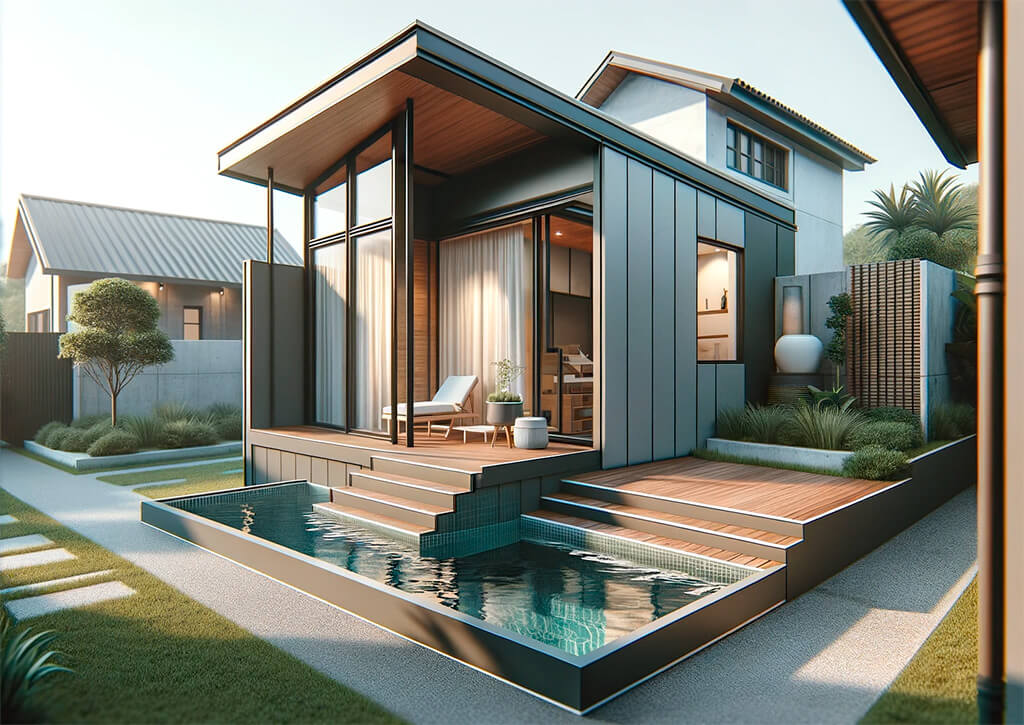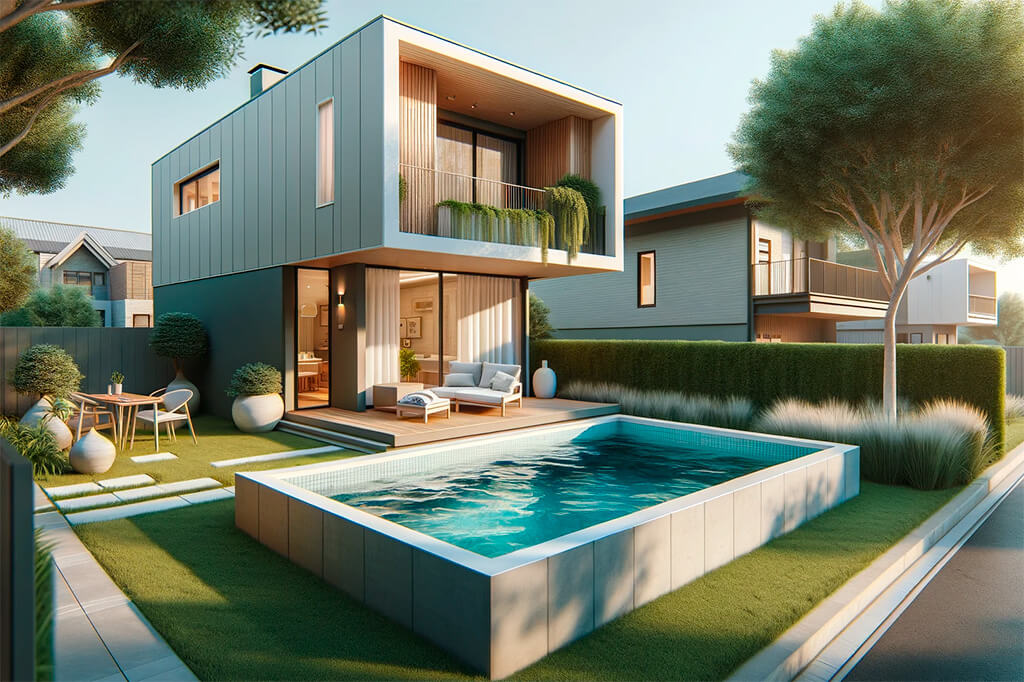In the ever-evolving world of home renovations, one trend that’s making a significant splash is prefab plunge pools. These compact, convenient pools are a boon for both the seasoned home handyman and the entrepreneurial construction professional. They offer a practical solution for adding a touch of luxury and leisure to a property, especially where space and resources are limited.
Prefab plunge pools are not just a quick fix for adding value, they represent a smart, space-saving solution for those looking to enhance their outdoor living spaces. For those in the business of home improvement, or even for the DIY enthusiast, these pools are an accessible pathway to elevate a property’s appeal and functionality.

Understanding Prefab Plunge Pools
Prefabricated plunge pools are essentially ready-made pools manufactured offsite and delivered ready for installation. Their construction typically involves robust materials like fiberglass or concrete, molded into various shapes and sizes to suit different preferences and spaces.
When compared to traditional swimming pools, prefab plunge pools are a different breed. Traditional pools are a major undertaking – a symphony of excavation, framing, plumbing, and a host of other complex processes. Prefab pools, in contrast, offer a streamlined approach: prepare the site, position the pool, connect the essentials like plumbing and electrical, and the job’s done. This simplicity and efficiency make them a preferable choice for many homeowners and builders.
Types of Prefab Plunge Pools
Concrete Plunge Pools:
- Features: Built to last with customization options in shape and finish.
- Benefits: These pools offer longevity and can contribute to the long-term value of a property.
Small Plunge Pools:
- Ideal For: Tailored for smaller spaces where a full-sized pool isn’t feasible.
- Perks: They provide the luxury of a pool without overwhelming your outdoor space.
Inground vs. Above Ground:
- Inground Pros: They offer seamless integration into your landscape, more depth options, and are generally seen as more aesthetically pleasing.
- Inground Cons: They come with a higher price tag due to the need for excavation and more complex installation.
- Above Ground Pros: Easier on the wallet and simpler to install. Some models even offer portability.
- Above Ground Cons: They tend to be less durable and are often viewed as less appealing than their inground counterparts.

Cost and Time Efficiency
Cost Comparison:
- Prefab plunge pools typically come in at a lower price point than traditional pools, primarily due to the reduced labor and material costs associated with their installation.
- You could expect savings in the ballpark of 20-30% compared to a conventional pool, though this can vary based on the pool’s size and type.
Time-saving Aspects:
- The installation of a prefab pool can be completed within a week, a stark contrast to the months often required for a traditional pool project.
- This swift turnaround minimizes disruption to your daily life and quickly transforms your backyard into a recreational retreat.
Installation Process
When it comes to installing a prefab plunge pool, the process, while less complex than traditional pool construction, requires meticulous attention to detail and a methodical approach to ensure long-term success and safety.
Preparing the Site:
- Site Clearance: Begin by clearing the designated area of any debris, vegetation, or obstacles. A clean and unobstructed site is crucial.
- Ground Leveling: Employ a spirit level to ensure the ground is perfectly level. This is a critical step, as an uneven base can lead to structural issues and uneven water distribution in your pool.
- Marking the Layout: Once you have the dimensions of your pool, mark out the exact area using spray paint or stakes and string lines. Accuracy here is key to ensure a smooth installation process.
Installation Steps:
- Excavation: Excavate the marked area to the required depth. This step should be approached with precision, an extra pair of experienced hands can be invaluable here.
- Base Preparation: A stable and well-drained base is essential. Lay a bed of gravel or coarse sand to act as a stable foundation and aid in drainage.
- Placing the Pool: Depending on the pool’s size and weight, this step may require machinery like a crane. Lower the pool carefully into the prepared excavation.
- Connections: Plumbing and electrical connections are next. It’s advisable to hire a professional for this phase to ensure compliance with local codes and safety standards.
- Backfilling: Fill in the gaps around the pool, using soil or gravel. Compacting this material is crucial to prevent future shifting or settling.
- Finishing Touches: Add water, set up the filtration system, and carry out a final check of all systems before use.
Safety Measures:
- Fencing: Install safety barriers to prevent unsupervised access, especially by children and pets.
- Non-Slip Surfaces: Opt for slip-resistant materials around the pool to prevent accidents.
Maintenance and Care
Regular Maintenance Tips:
- Skimming and Cleaning: Regular removal of debris and periodic cleaning of the pool’s walls is necessary to prevent algae and maintain water clarity.
- Water Chemistry: Regularly testing and adjusting the pool’s pH and chlorine levels is vital for a safe and enjoyable swimming environment.
- Filter Maintenance: Regular cleaning and, when necessary, replacement of the pool’s filters are essential to maintain water quality and circulation.
Seasonal Care:
- Winter Preparation: In colder climates, taking steps to winterize your pool is crucial to protect it from freezing temperatures and potential damage.
- Summer Opening: Before the swimming season, thoroughly clean the pool, check all systems, and balance the water chemistry for optimal summer use.
Customization and Design
Design Options:
- Tile and Finishes: Select tiles and finishes that complement the style of your home and landscape.
- Lighting: Consider installing underwater LED lights for both safety and ambiance.
Adding Personal Touches:
- Landscaping: Thoughtful landscaping around the pool can enhance its appearance and provide privacy.
- Outdoor Furnishings: Quality outdoor furniture can transform the pool area into a comfortable and inviting space.
- Additional Features: If space allows, features like a fire pit or BBQ area can extend the functionality and enjoyment of your outdoor space.
Benefits of Prefab Plunge Pools
Drawing from years of experience in home renovation, it’s clear that prefab plunge pools offer unique advantages, particularly in urban settings where space can be at a premium.
- Space-saving Solutions: These pools are ideally suited for smaller backyards, allowing homeowners to maximize their outdoor space without the pool dominating the landscape.
- Eco-friendly Options: Today’s prefab pools often incorporate sustainable practices in both construction and operation. From energy-efficient pumping systems to environmentally friendly materials, these pools reflect a growing commitment to eco-conscious living.
- Health and Wellness Benefits: Beyond leisure, these pools provide substantial health benefits. They’re excellent for low-impact exercise, which is particularly beneficial for those with joint issues, and the mental health benefits of having a tranquil water feature at home are well-documented.
Common Challenges and Solutions
In my years in construction, I’ve encountered and overcome various challenges associated with installing prefab plunge pools.
- Installation Challenges: Leveling issues are common, especially in older yards. Proper grading and preparation of the site are crucial for a successful installation. For areas with drainage issues, incorporating a well-designed drainage system is key.
- Troubleshooting Tips: For issues with pumps or filtration systems, start with the basics: check for blockages or mechanical failures. Regular maintenance is the best prevention against most common problems, but when in doubt, consulting a professional is always advisable.
FAQ Section
Costs vary, typically falling between $10,000 to $25,000. Factors influencing price include size, materials, and additional landscaping or decking.
On average, installation takes about a week, significantly quicker than traditional pools. This timeline can vary based on site conditions and installation complexity.
Yes, these pools are designed for compact spaces. Ensuring safe and accessible surroundings is crucial in planning the layout.
Yes, with proper care and maintenance, these pools, made of materials like fiberglass and concrete, are designed for longevity.
Maintenance is less intensive than for traditional pools but includes regular cleaning, pH balancing, and filter maintenance.
